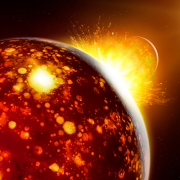A group of scientists who placed instruments on an ice shelf in Antarctica found that ponds of meltwater were causing the ice to flex and fracture.
Though scientists had predicted the phenomenon, this is the first time it was observed in the field.
The finding raises concerns that, as climate change progresses and more melting occurs, vulnerable ice shelves in Antarctica will collapse—contributing to global sea rise.
“Ice shelves are extremely important for the Antarctic Ice Sheet’s overall health as they act to buttress, or hold back, the glacier ice on land,” said Alison Banwell, a scientist in the Cooperative Institute for Research in Environmental Sciences (CIRES) at the University of Colorado Boulder and lead author of the study published May 4 in the Journal of Glaciology. “Scientists have predicted and modeled that surface meltwater loading could cause ice shelves to fracture, but no one had observed the process in the field, until now.”
“It’s looking very likely that this process explains the collapse of the Larsen B Ice Shelf,” added Doug MacAyeal, University of Chicago Prof. Emeritus of Geophysical Sciences and co-author on the paper—referring to a notorious 2002 event in which more than 1,000 square miles of Antarctic ice collapsed into the ocean in a matter of weeks.
Pooling evidence
Around the continent of Antarctica, thick sheets of floating glacier ice extend out over the ocean. Known as ice shelves, they are thought to help keep inland glaciers stable—but more and more seem to be collapsing.
In 2019, a group of researchers led by Banwell traveled to the George IV Ice Shelf, thought to be one of the at-risk ice shelves in Antarctica. They placed time-lapse cameras and GPS sensors to monitor the ice over the course of a year, throughout the seasonal cycle of freezing and thawing.
The outbreak of COVID-19, however, meant it was more than a year before they could return. When they returned in late 2021, several of the stations had been lost. Fortunately, some instruments survived—and they had documented a lot of evidence.
According to the research, here’s how the process works. Warmer air temperatures cause the top layers of ice on the ice shelf to melt. The newly liquid water forms a pool, which concentrates the weight in one area. Then, as anyone who’s tried to cup water in their hands knows, the water will find its way down through even the tiniest crack.
The water trickling down widens the cracks in the ice, like cracks spreading from a pothole in the road over time. Over the course of the summer, the pools fill and then drain, over and over; the GPS sensors placed atop the ice shelf recorded that the ice shelf was dropping and rising by about a foot each time. This further weakens the ice.
Ice is structurally fragile, MacAyeal said; “It’s like a weak form of glass.”
Eventually, the dam breaks. The GPS stations recorded a very sudden altitude change—meaning the ice had fractured.
A time-lapse video captured by the cameras shows how the meltwater pools stress and fracture the ice.
The researchers said it was likely this thawing and freezing cycle was a key factor in the collapse of the Larsen B Ice Shelf in 2002, the largest ice shelf breakup on record. Before the event, satellites had recorded many pools of meltwater atop the ice shelf.
Global sea levels have risen by eight to nine inches since 1880, and the trend is accelerating over time. The melting of Antarctic ice is a major factor, and scientists worry that the loss of the ice shelves will further destabilize the situation.
“These observations are important because they can be used to improve models to better predict which Antarctic ice shelves are more vulnerable and most susceptible to collapse in the future,” Banwell said.
Researchers from the University of Cambridge and the University of Oxford were also co-authors on the paper.
Citation: “Observed meltwater-induced flexure and fracture at a doline on George VI Ice Shelf, Antarctica.” Banwell et al, Journal of Glaciology, May 3, 2024.
Funding: U.S. National Science Foundation (NSF), U.K. Natural Environment Research Council (NERC)

